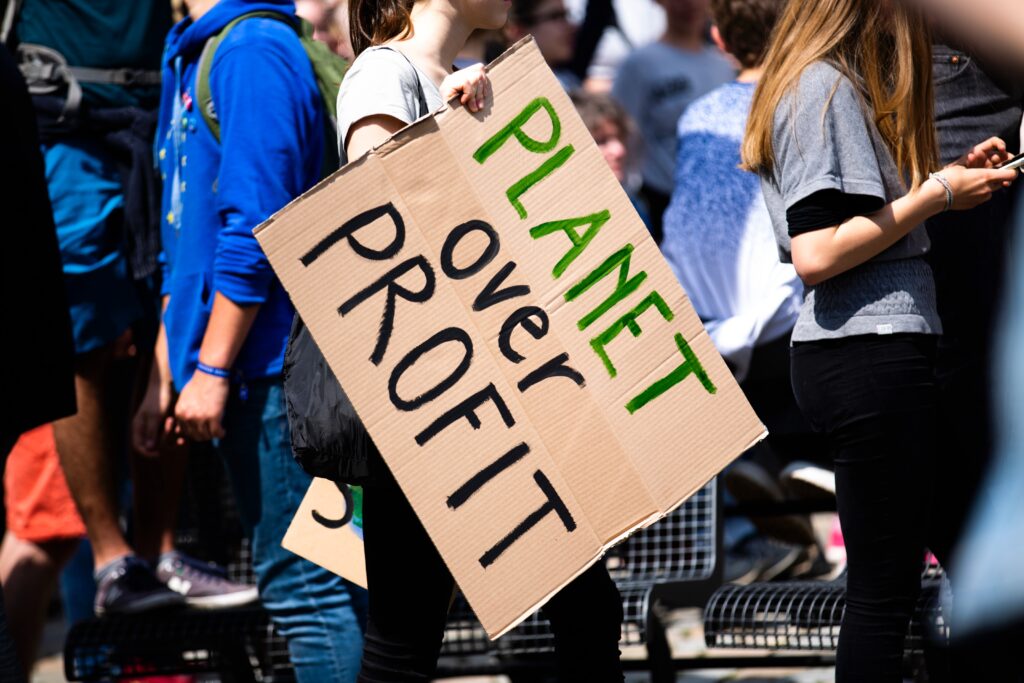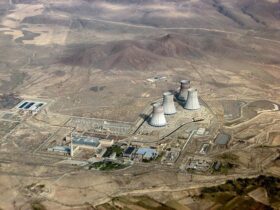By Kirian Mischke-Reeds and Carmen Santiago-Ubauer
LOS ANGELES — With each passing day, climate change becomes an increasingly dangerous crisis. Last May, carbon dioxide levels hit 417 parts per million, a concentration not seen on Earth in nearly 4 million years. In 2020, global temperatures were 2.16ºF (1.2ºC) hotter than the average year 200 years ago. The world is witnessing natural disasters exacerbated by climate change, from catastrophic and record-setting fires, devastating storms and floods and drastic ice and forest cover loss. And the symptoms of climate change are only expected to become more severe.
With the reality of climate change settling in for more people than ever before, the conversation is shifting to one of mitigation and resilience. Essentially, what can be done to prevent the worst?
Multinational oil and gas company ExxonMobil first noticed the potential dangers of rising CO2 in the 1950s and 1960s and chose to cover up their findings. Over 70 years later, the world is more temporally strapped than ever — drastic action is required to meet the Paris Agreement’s goal of limiting warming to less than 2ºC. Efficiency is now an utmost priority.
This article will discuss and review two different approaches to mitigation, examining the merits and downsides of advocating for institutional change or for widespread individual action. We ultimately leave the decision on which approach is most effective up to you, the reader, but hope that you see the advantages to both.
Kirian Mischke-Reeds: The World Needs to Prioritize Institutional Change
If the world can shift its global financial and political systems to prioritize dealing with the climate crisis and successfully get enough momentum behind change, mitigation efforts and resilience building will be more effective than any changes in consumer behavior could accomplish.
Before I begin my argument, I believe it is important to define what I mean by “institutions” and “institutional change.”. The word “institutions, as I’m using the term in this article, is used as a blanket placeholder term for large corporations, governments, and international organizations. While it might seem strange to lump these entities together, they are the predominant power brokers in the world, with the largest influence and impact.
Climate change has already become too large a problem for individuals to comprehend, let alone solve. The changes necessary to meet RCP2.6, the pathway compliant with the Paris Agreement, are drastic, to say the least. RCP2.6 refers to Representative Concentration Pathway 2.6, the level of warming consistent with a 2.6 W/m2 increase in radiative forcing by 2100. Simply put, this means that, as a result of anthropogenic greenhouse gas (GHG) emissions, there will be more 2.6 watts of energy per square meter for the whole Earth. There’s significantly more heat getting trapped in the atmosphere than is leaving the planet and as a result, things are getting hotter and climates are shifting. RCP2.6 is the current goal of global climate mitigation, to restrict radiative forcing to only 2.6 watts per square meter and not the 8.5 watts per square meter we’re currently on a trajectory to achieve, which will bring about catastrophic and irreversible effects.
Achieving RCP2.6, which still entails warming of 0.9 to 2.3ºC, will require steep and immediate decreases in GHG emissions and is likely already unfeasible. Achieving the Paris target of limiting warming to 1.5ºC would require reducing global GHGs by half by 2030, with net-zero being achieved by 2050. Notwithstanding the artificial COVID-induced dip in 2020, global emissions have only increased since the Paris Agreement was signed. We need to focus our efforts on the world’s top emitters. According to the 2017 Carbon Majors report, over half of global industrial emissions since 1988 are the result of 25 corporations and states. This infamous list includes state-owned fossil fuel companies like Saudi Aramco (2), Gazprom (3), and National Iranian Oil (4), as well as companies like ExxonMobil (5) and BP (11).
Institutions are to blame. It was their actions and behavior that allowed the current crisis to fester in the first place. It’s disingenuous and dangerous to place the responsibility of tackling climate change on individuals when it has largely been the result of decisions made by governments and corporate leaders. An emphasis on profit over humanity for the last several centuries has resulted in an extractionist, increasingly global economy that exploits natural resources for economic growth.
But an institution’s weaknesses can also be its strengths. Traditionally, it has been difficult to change the behavior of notoriously bureaucratic and slow to act international organizations such as the United Nations, the International Fund, the World Bank, or the European Union. However, with enough momentum and pressure, these institutions act with the advantage of resources and global clout. Formal structures governed by charters, constitutions and laws outlast individual leaders and can carry momentum and international weight longer. If we focus our efforts on forcing institutions to change their behavior, we can harness institutional rigidity for good.
By advocating for this, however, I am by no means trying to ignore the lifestyle changes that will be necessary to accomplish effective mitigation efforts, nor do I wish to discredit individual efforts to reduce emissions and build resilience. I am, however, skeptical that a critical mass of consumers would be willing, despite increased awareness of climate change, to change their behavior in a meaningful and timely fashion. If previous examples of human behavior are anything to go by, people are serial procrastinators, even in the face of crises. The world did not care about pollution in the Cuyahoga River, until it caught fire and photos documenting the blaze were published around the world. Eliminating plastic straws gained popularity in 2018, if only because it became trendy. Essentially, people have not yet proven that they are capable of addressing environmental issues through our capitalistic framework in a rapid enough time frame.
I’m not against individual change because it is ineffective; in fact, quite the opposite, we will need mass mobilization and consumer pressure to force institutions to change their behavior. But, relying on individuals to make alterations to their lifestyle, when doing so is economically inefficient currently, is risky at best and dangerous at worst. Climate change is an existential issue, but only a third of consumers surveyed by grocery giant Unilever said they were choosing to buy from brands that they believed were more environmentally friendly. While people are aware of the threat the climate crisis poses, not enough are willing or able to make the changes necessary to drive shifts in institutional behavior.
Changes in individual purchasing behavior will reduce individuals’ own carbon footprint while, at scale, pushing corporations to adapt to a new, more environmentally conscious consumer demand for products, thus changing their behavior. The same kinds of changes could be accomplished more efficiently and effectively the other way around: institutions change their behavior, thus pushing individuals to change their consumption habits as well.
Collective action to pressure governments and corporations to take more ambitious steps towards mitigation is the best way forward. These changes will be as expansive as they are expeditious. And we will need to focus our attention and efforts on achieving institutional change as the most efficient, just, and achievable strategy towards combating the climate crisis.
Carmen Santiago-Ubauer: Individuals Must Take Responsibility for the Climate Crisis
The focus on institutional change has allowed individuals to opt out of their personal responsibility to protect the planet. The idea that governments should do the work for us, or that public and private sector innovation will find a way to “save us” from climate change, discourages the average global citizen from making sustainable lifestyle changes.
Individual change is especially important considering that governments are not the main cause of climate change ‒ people are.Governments did not create the majority of the destructive industries that contribute to climate change (though, they have admittedly supported them and allowed them to continue to wreak havoc), individuals did. Individuals support these exploitative industries every day when they choose to eat animal products, buy fast fashion, use copious amounts of plastics and disposable materials, waste clean water and electricity, travel excessively and more. Individual behavior is critical in understanding the drivers of climate change.
It feels counterintuitive to blame the average person for global climate change, a problem Kirian aptly contextualizes above, but we must recognize that every individual has a carbon footprint. Those individuals with the privileges of choice, education and relative wealth, should do everything in their power to reduce their carbon footprint and positively impact the environment.
There is no denying that some individuals deserve more blame than others. Those individuals that drive the corporations that exploit the environment and produce copious amounts of greenhouse gases contribute to climate change far more than the average person. These are the individuals we need to change the most, but they have no current incentive to do so. They continue to make money and collect wealth, because average citizens pay for their products and services, like water, gas, electricity, oil and more — which are necessary goods in many economies. But consumers with the privilege to choose among companies can opt against giving destructive corporations their dollars, and thus, can diminish their negative impact on the environment in the long run.
Consumers too often underestimate the power they have to shift the national and global economy toward greater sustainability and, in doing so, combat climate change. In fact, according to a University of Oxford study, if the world were to go vegan by 2050 ‒ meaning everyone would adhere to a plant-based diet ‒ food-related emissions would decrease by nearly 70%, 8.1 million health-related deaths would be avoided, and the world could save up to $31 trillion in GDP. This is especially significant considering the fact that food-related emissions account for more than a third of greenhouse gas emissions.
Naturally, a scenario in which the entire human population adopts a predominantly plant-based diet seems highly unlikely. But, it may not be as far-fetched as you think. Gradually, more and more people are reducing their animal product consumption as they become more conscious of the agricultural industry’s environmental impacts. In fact, some estimates show that up to a third of the human population currently follows a diet based on the moderation or elimination of animal products. As a result of the flourishing plant-based movement, the popularity and profitability of plant-based products has skyrocketed, and companies such as Impossible Foods and Beyond Meat have grown exponentially. In response to these trends, Big Meat companies, such as Tyson, Smithfield, Perdue and Homel, have begun to produce meat alternatives as well. This demonstrates just how much power consumers hold ‒ even the largest corporations will adapt to meet their desires.
Consequently, individuals should view everything they consume as an investment, and change their consumer behavior accordingly. Do not buy red meat if you do not want to invest in animal agriculture, which is responsible for 14.5% of anthropogenic greenhouse gases and rampant deforestation. Do not buy fast fashion if you do not want to invest in an industry that produces up to 10% of global emissions and massive landfills of textile waste. Do not buy single-use plastics if you do not want to invest in the fossil fuels and petrochemicals industry and the 8 million tons of plastic polluting our oceans. Instead, invest in local farms, local artisans and creators, and innovative and sustainable companies, by purchasing and promoting their products. Naturally, no one can be the perfect consumer, but everyone can try, and keep trying harder every single day.
Why rely on slow-moving institutional change, when so much change can be motivated by individuals?
This argument is often met with the rebuttal, “but, one person can’t make a difference.” This feeling that we’re too small in the grand scheme of things to truly have an impact is a self-fulfilling prophecy.
If the world does not believe in the collective power of individuals, then it cannot harness this power to defeat climate change.






